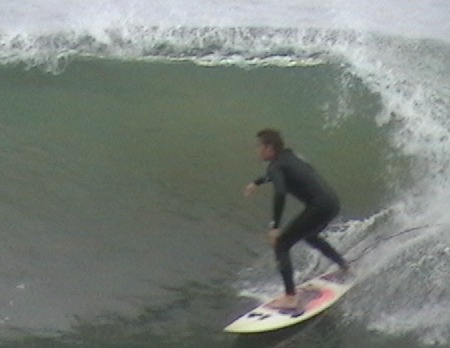One key to over coming fear of bigger surfing waves is not to jump up in class too fast. We can’t go from riding 4′ waves to riding 8′ waves.
When I teach Surf Lessons in Oceanside, we learn the fundamentals on foam waves. There is a reason. There is no reason to go to bigger waves or shorter boards until you have mastered each step. You should practice the pop up on smaller waves until it is accurate, stable, and in muscle memory.
Advancing to Real Waves
Once the pop up is mastered and you don’t fall off small foam waves, start with bigger foam waves and then real waves. We often start with real waves by catching the corners and then moving to the apex where the power resides. Real key in having confidence in catching real waves is being able to escape close outs. We practice our bottom turns to get into the pocket on real waves and then to escape over the top of close outs.
The fear of surfing bigger surfing waves is stemmed by great conditioning. Being confident in our stamina is important. Surfing is tiring. We don’t want to tackle bigger waves if we are not full of energy to handle big dunkings. I never want to be in the position of being too tired to fight for my life or at least a long hold down in a big wave. A big wave has different meanings and sizes for each of us.
Confidence Grows
We have to have confidence in our wave catching ability. The proper technique is getting in front of the wave and letting it come under you. If you paddle over the top of waves chasing them, you are going to get caught in close outs often. You have to paddle in front which requires timing and positioning and, of course, experience. Start on smaller waves to get in front and allowing waves to arc over your head (short boards). Then it should only require a couple of paddles to get down the face and pop up.
Watch the wave at all times to know what it is doing. Many times I might change the direction I will travel. I might realize I have to go down the face or maybe I can angle into the pocket immediately. The bigger the wave, the more you are forced to first ride the face and then carve into the pocket.
Key is being able to ride square on the board with your hips and shoulders facing forward. If you pop up with your butt over the rail, as i call it, and a hand trailing instead of both being in front, you are going to be off balance quickly. Your shoulders have to be square facing the front. If you are going to grab a rail immediately and dive into the pocket on a close out, you will have your butt into the wave face to hold an edge.
Practicing on inside waves that are steeper and faster is good practice. You always need to maintain good form, be smooth, and land accurately.
For Surf Lessons in Oceanside, visit the Home Page
